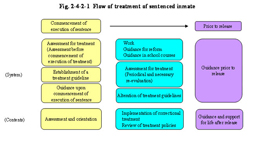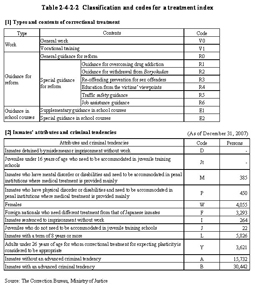| Previous Next Index Image Index Year Selection | |
|
|
1 Overview of treatment The Penal Detention Facilities Act was enforced and efforts have been made to improve treatment of sentenced inmates. Fig. 2-4-2-1 shows the flow of treatment of a sentenced inmate in a penal institution. Based on the Penal Detention Facilities Act, treatment of sentenced inmates aims to make inmates aware of themselves according to their individual attributes and environment, arouse their willingness to reform and rehabilitate themselves, and foster their ability to adapt to social life. Correctional treatment has come to be carried out mainly through three types of activities: work, guidance for reform, and guidance in school courses. Fig. 2-4-2-1 Flow of treatment of sentenced inmate Correctional treatment is implemented based on a treatment guideline that specifies goals, basic contents and methods for individual inmates' correctional treatment in response to assessment of their personal characteristics and environments. Sentenced inmates are to be classified into groups as needed for carrying out effective treatment. The classification for that purpose is called group classification of inmates.Establishment of treatment guidelines and group classification are based on assessment for treatment carried out before commencement of execution of sentence, and on a periodical and temporary basis, utilizing expertise and technology in medicine, psychology, education, sociology, and others. Special institutions are designated as assessment centers in each of the Regional Correction Headquarters, which make the detailed assessment of (i) newly imprisoned juvenile sentenced inmates under 16 years of age whose term of imprisonment is three months or more, (ii) newly imprisoned male juvenile sentenced inmates 16 years of age or older but under 20 years of age whose term of imprisonment is one year or more, and who have never been imprisoned before (excluding those classified into Class F (foreign nationals who need different treatment from that of Japanese inmates)), (iii) newly imprisoned male sentenced inmates 20 years or older but under 26 years of age, whose term of imprisonment is one year and half or more, and who have never been imprisoned before (excluding those classified into Class F and Boryokudan (organized crime groups) members), and (iv) those for whom examination is especially needed upon providing special rehabilitation guidance (inmates for sexual offenses, etc.). A treatment index is specified for respective sentenced inmates in conducting group classification. A treatment index is organized in terms of types and contents of correctional treatment and inmates' attributes and criminal tendencies. Facilities and prior policies of treatment suitable for respective inmates are determined based on the treatment index. Table 2-4-2-2 shows the classification and codes for a treatment index. Table 2-4-2-2 Classification and codes for a treatment index (2) Day leave and furloughDay leave and furlough is a system to allow inmates who meet certain requirements, such as receiving treatment in an open facility, to temporarily go outside penal institutions without being accompanied by institution staff when they need to do certain businesses. Day leave should be a one-day trip and furlough should be within seven days. Certain businesses include cases where it is necessary to have talks with a person outside institutions for hours so as to ensure a dwelling place or working place after release or maintain or arrange family relationships, or cases where it is necessary to visit a volunteer probation officer or others related to rehabilitation. This system is expected to contribute to the rehabilitation of inmates by providing them with opportunities to get ready for smooth transition to life after release. (3) Alleviation of restrictions and privilege measures Alleviation of restrictions is the system where restrictions on sentenced inmates' daily life and activities are gradually alleviated in accordance with their achievements while serving their sentences in order to cultivate the self-control and self-reliance of them. As of April 10, 2008, 525 inmates (0.8%) had been designated as Level 1 who are very likely to have been motivated to have reformed and rehabilitated themselves and develop the adaptability to life in society, 2,289 (3.3%) as Level 2, 56,132 (81.6%) as Level 3, 3,552 (5.2%) as Level 4, while 6,330 (9.2%) have no designation (Source: The Correction Bureau, Ministry of Justice). Privilege measures aim to evoke sentenced inmates' willingness for reformation and rehabilitation by giving privilege measures such as an increased number of contacts with the outside world and expansion in the range of self-supplied articles to inmates leading sober lives in accordance with a relatively short-term assessment of their attitude toward their sentence. As of April 10, 2008, 174 inmates (0.3%) had been designated as Level 1, a privilege level for those whose attitudes are especially good, 5,652 (8.2%) as Level 2, 30,805 (44.8%) as Level 3, 8,238 (12.0%) as Level 4, while 14,415 (20.9%) had no designation (based on the result of examination of 75 major penal institutions, eight branch prisons, and four large-scale branch detection houses (Sapporo, Yokohama, Saitama, and Kokura)) (id.). |

